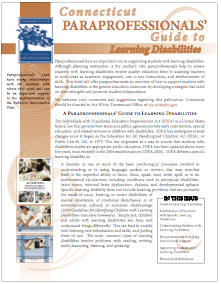CT Guidelines for Physical Therapy in Educational Settings
Overview:
Physical therapy and the physical therapist’s role in educational settings have evolved along with educational reforms. More recently therapists, school administrators and teachers are searching for service models relevant to educational environments and curriculum. Parents, students, and school personnel seek collaboration, mutual decision-making, and inclusion of students with their peers as much as possible. However, the education and training for physical therapists covers services in many settings such as hospitals, nursing homes and schools. Training includes assisting people of all ages, using diverse therapy approaches.
- URL: http://portal.ct.gov/-/media/SDE/Special-Education/PTGuidelines.pdf
- Publication Date: 1999
- Content Type: Physical Therapy, ISSS, Guidelines
- Grade Level: Elementary School, Middle School, High School
CT Guidelines for Occupational Therapy in Educational Settings
Overview:
Occupational therapy and the occupational therapist’s role in educational settings have evolved along with educational reforms. More recently therapists, school administrators, and teachers are searching for service models relevant to educational environments and curriculum. Parents, students and school personnel seek collaboration, mutual decisionmaking, and inclusion of students with their peers as much as possible. However, the education and training for occupational therapists covers services in many settings such as hospitals, nursing homes and schools. They are trained to assist people of all ages, using diverse therapy approaches.
- URL: http://www.sde.ct.gov/sde/lib/sde/PDF/DEPS/Special/OTGuidelines.pdf
- Publication Date: 1999
- Content Type: Occupational Therapy, ISSS, Guidelines
- Grade Level: Elementary School, Middle School, High School
CT Guidelines for Identifying and Educating Students with Serious Emotional Disturbance
This guideline document is intended to provide educators in Connecticut with recommended practices concerning eligibility determination, assessment, and program services for students with serious emotional disturbance (SED). As described in these guidelines, students with SED exhibit atypical behavior that is persistent, generalized and extended over time and situations. Their atypical behavior adversely affects their educational performance and is significantly deviant from and infrequently seen among their age-level peers. Although many students may at times exhibit disturbing school behavior that appears consonant with the definition of serious emotional disturbance, they are not necessarily eligible for special education services. The absence of key distinguishing features (e.g., pervasiveness, limited control of their actions) will preclude some students from meeting the criteria for having a serious emotional disturbance. These considerations and other features will be described and clarified within this document.
- URL: http://www.sde.ct.gov/sde/lib/sde/PDF/DEPS/Special/SEDguide.pdf
- Publication Date: 1997
- Content Type: Emotional Disturbance, Guidelines
- Grade Level: Elementary School, Middle School, High School
CT Teacher Supervisory Checklist
A Checklist of Knowledge and Skills for Teachers Supervising Paraprofessionals in Preschool‐12
CT Assessment Checklist for Paraprofessionals
Paraprofessionals are an important part of the early intervention and educational workforce. As articulated in the introduction of the Connecticut Guidelines for Training and Support of Paraprofessionals Working with Students, Birth to 21 (2004), “paraprofessional roles and responsibilities continue to grow and systems must work diligently to ensure high quality personnel and services (page 4)”. This Assessment Checklist for Paraprofessionals (AC) is designed to aid teachers, supervisors, and administrators to support and enhance the skills of paraprofessionals through training and ongoing supervision. This assessment is also intended to be used as a guide for paraprofessionals in self-assessment and self-improvement, a collaborative informal assessment between paraprofessional and supervisor, a needs assessment regarding paraprofessionals in a school or district, and/or a guide in the design of professional development for paraprofessionals.
CT Guide for the Training, Use and Supervision of Speech-Language Pathology Aides and Assistants in Connecticut
This document integrates material taken directly from the American Speech-Language-Hearing Association (ASHA) Guidelines for the Training, Credentialing, Use and Supervision of SpeechLanguage Pathology Assistants (Asha, 38, Spring 1996), and the Report the Consortium of Organizations on the Preparation and Use of Speech-Language Paraprofessionals in Early Intervention and Educational Settings (CEC, January, 1997). This implementation guide addresses Connecticut’s diverse settings and current requirements for the provision of speech-language pathology services.
Paraprofessionals and SRBI
This document, Paraprofessionals and SRBI, is the first in a series of documents to provide guidance and support to districts in the implementation of the SRBI framework.
LRE News Spring/Summer 2010: Paraprofessionals
This issue of the CT LRE News from 2010 focuses on the contributions of paraprofessionals to high-quality educational programming for students with disabilities.
Frequently Asked Questions About Paraprofessionals
What is Connecticut’s definition of a paraprofessional?
A paraprofessional is an employee who assists teachers and/or other professional educators or therapists in the delivery of instructional and related services to students. The paraprofessional works under the direct supervision of the teacher or other certified or licensed professional. The ultimate responsibility for the design, implementation, and evaluation of instructional programs, including assessment of student progress, is a collaborative effort of certified and licensed staff.
Connecticut Paraprofessionals Guide to Learning Disabilities

- Guide to Learning Disabilities
- Identification of Students with Specific Learning Disabilties
- Understanding Students with Learning Disabilities
- Paraprofessionals Providing Instructional Support
- Supporting Students with Learning Disabilities
Download PDF

